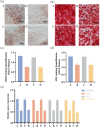New considerations in selecting donors for dental pulp stem cells: a pilot study
- PMID: 40119437
- PMCID: PMC11929365
- DOI: 10.1186/s12938-025-01367-8
New considerations in selecting donors for dental pulp stem cells: a pilot study
Abstract
Background/purpose: Tissue engineering based on stem cell therapy necessitates a substantial quantity of high-quality stem cells. However, current sources face limitations, including narrow donor pools, compromised biological properties due to cryopreservation, and cellular senescence resulting from in vitro passaging and expansion. This study examines the impact of mild periodontitis on the biological performance of dental pulp stem cells (DPSCs) to explore the potential of broadening the donor pool for these cells.
Materials and methods: The experiment included two variables: age and the presence of periodontitis. DPSCs were isolated from six healthy subjects and six patients with mild periodontitis. Healthy subjects were categorized into Groups A (28-32 years) and B (52-54 years), and patients with mild periodontitis were categorized into Groups C (31-33 years) and D (50-53 years). The analyses included cell morphology, proliferation rate, multilineage differentiation capacity, apoptosis, and surface marker expression.
Result: No significant differences in cell morphology, pluripotency, or senescence were observed between healthy controls and periodontitis patients across age groups. Additionally, data on proliferation, pluripotency, and senescence were not significantly different. In healthy subjects, increased age was correlated with more elongated, flattened, and broader cells, alongside greater heterogeneity and intercellular granules. The proliferation and differentiation capacities decreased, whereas the degree of apoptosis increased. Similar trends were noted in patients with periodontitis.
Conclusion: The biological properties of DPSCs remain unchanged in teeth with mild periodontitis, providing valuable insights for addressing the shortage of DPSCs in tissue engineering. Teeth with mild periodontitis have the potential to be pulp stem cell donors.
Keywords: Dental pulp stem cells (DPSCs); Periodontitis; Regenerative medicine; Tissue engineering.
© 2025. The Author(s).
Conflict of interest statement
Declarations. Ethics approval and consent to participate: The study was conducted in accordance with the Declaration of Helsinki and was approved by the Ethics Committee of Qingdao Stomatological Hospital (2023KQYX060, June 2023). Informed consent was obtained from all the subjects involved in the study. Written informed consent has been obtained from the patient(s) to publish this paper. Competing interests: The authors declare no competing interests.
Figures





Similar articles
-
Investigation of dental pulp stem cells isolated from discarded human teeth extracted due to aggressive periodontitis.Biomaterials. 2014 Nov;35(35):9459-72. doi: 10.1016/j.biomaterials.2014.08.003. Epub 2014 Aug 27. Biomaterials. 2014. PMID: 25172527
-
Preliminary Evaluation of Proliferation, Wound Healing Properties, Osteogenic and Chondrogenic Potential of Dental Pulp Stem Cells Obtained from Healthy and Periodontitis Affected Teeth.Cells. 2021 Aug 18;10(8):2118. doi: 10.3390/cells10082118. Cells. 2021. PMID: 34440887 Free PMC article.
-
Analysis of Senescence-Related Differentiation Potentials and Gene Expression Profiles in Human Dental Pulp Stem Cells.Cells Tissues Organs. 2017;203(1):1-11. doi: 10.1159/000448026. Epub 2016 Sep 15. Cells Tissues Organs. 2017. PMID: 27627434
-
Systematic Review of Human Dental Pulp Stem Cells for Cartilage Regeneration.Tissue Eng Part B Rev. 2020 Feb;26(1):1-12. doi: 10.1089/ten.TEB.2019.0140. Epub 2020 Jan 22. Tissue Eng Part B Rev. 2020. PMID: 31744404
-
Intrinsic and extrinsic modulators of human dental pulp stem cells: advancing strategies for tissue engineering applications.Mol Biol Rep. 2025 Feb 3;52(1):190. doi: 10.1007/s11033-025-10281-0. Mol Biol Rep. 2025. PMID: 39899148 Review.
References
-
- Sharma D, Ross D, Wang G, Jia W, Kirkpatrick SJ, Zhao F. Upgrading prevascularization in tissue engineering: a review of strategies for promoting highly organized microvascular network formation. Acta Biomater. 2019;95:112–30. - PubMed
-
- Edgar L, Pu T, Porter B, Aziz JM, La Pointe C, Asthana A, et al. Regenerative medicine, organ bioengineering and transplantation. Br J Surg. 2020;107(7):793–800. - PubMed
-
- Han H, Chen B-T, Liu Y, Wang Y, Xing L, Wang H, et al. Engineered stem cell-based strategy: a new paradigm of next-generation stem cell product in regenerative medicine. J Control Release. 2024;365:981–1003. - PubMed
-
- Sarkar A, Saha S, Paul A, Maji A, Roy P, Maity TK. Understanding stem cells and its pivotal role in regenerative medicine. Life Sci. 2021;273: 119270. - PubMed
MeSH terms
Grants and funding
LinkOut - more resources
Full Text Sources
Medical

